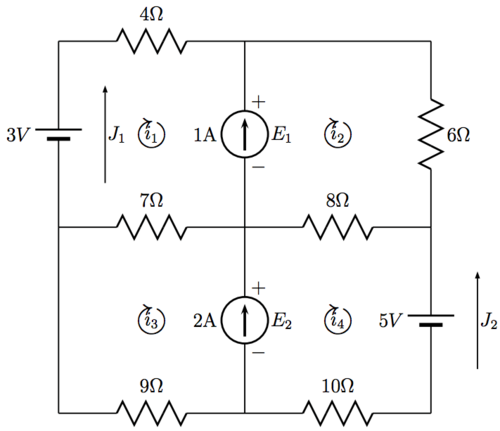Science:Math Exam Resources/Courses/MATH152/April 2011/Question A 10
{{#incat:MER QGQ flag|{{#incat:MER QGH flag|{{#incat:MER QGS flag|}}}}}}
• QA 1 • QA 2 • QA 3 • QA 4 • QA 5 • QA 6 • QA 7 • QA 8 • QA 9 • QA 10 • QA 11 • QA 12 • QA 13 • QA 14 • QA 15 • QA 16 • QA 17 • QA 18 • QA 19 • QA 20 • QA 21 • QA 22 • QA 23 • QA 24 • QA 25 • QA 26 • QA 27 • QA 28 • QA 29 • QA 30 • QB 1(a) • QB 1(b) • QB 1(c) • QB 2(a) • QB 2(b) • QB 3(a) • QB 3(b) • QB 3(c) • QB 4(a) • QB 4(b) • QB 4(c) • QB 4(d) • QB 5(a) • QB 5(b) • QB 5(c) • QB 6(a) • QB 6(b) • QB 6(c) • QB 6(d) • QB 6(e) •
Question A 10 |
|---|
|
In term of these unknowns [found in A9], write the linear equation that represents Kirchhoff's law of voltage drops around the third loop (corresponding to ) in the circuit above. |
|
Make sure you understand the problem fully: What is the question asking you to do? Are there specific conditions or constraints that you should take note of? How will you know if your answer is correct from your work only? Can you rephrase the question in your own words in a way that makes sense to you? |
|
If you are stuck, check the hint below. Consider it for a while. Does it give you a new idea on how to approach the problem? If so, try it! |
Hint |
|---|
|
A resistor can only have 1 current going through it so any branches that share loop currents must be added together (with direction considered of course!) |
|
Checking a solution serves two purposes: helping you if, after having used the hint, you still are stuck on the problem; or if you have solved the problem and would like to check your work.
|
Solution |
|---|
|
To be consistent with the labs, we will denote everything in terms of voltage drops so positive numbers are voltage drops and negative numbers are voltage gains. In the third loop we move clockwise and start with the 9 resistor. The voltage across this resistor (and any resistor) is given by Ohm's Law V=IR so where we have a positive sign because we're moving with the current and so there is a voltage drop. Next we come to the 7 resistor which has both loop current 3 and loop current 1 flowing through it. Therefore there is a voltage drop contribution from loop current 3 by virtue that we're moving in the direction of that current but there is also a voltage gain from loop current 1 going in the opposite direction. Therefore we get that . Finally we reach the current source; since we are traversing it against the arrow we have a voltage drop and the value is one of our unknowns, . The Kirchhoff rule states that the sum of voltage drops and gains in a loop must be zero and so we have that as the linear equation for loop 3. |
{{#incat:MER CT flag||
}}







